One of the highest achievements for any racehorse is winning the American Triple Crown. In fact, only 13 lucky horses have ever done it — that’s right, a grand total of just 13 in the past 100 years! Each legendary horse to win the Triple Crown has its own unique story and has captured the hearts of racing fans everywhere. So, grab your binoculars as we head down the track and explore the stories behind the only 13 horses to win the Triple Crown!
What is the Triple Crown?
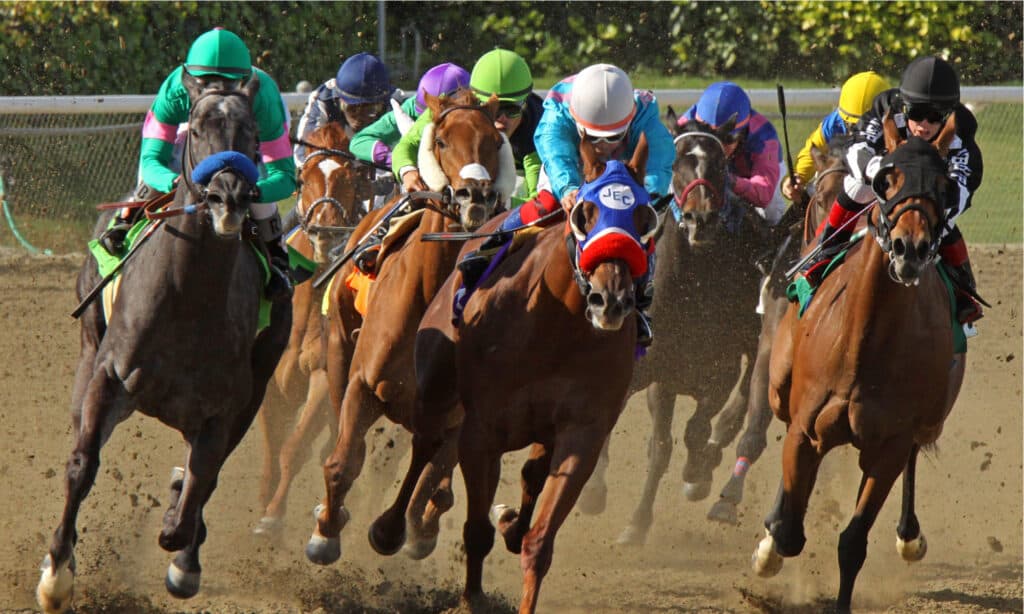
The American Triple Crown is an award for the horses that win the Kentucky Derby, Preakness Stakes, and Belmont Stakes.
©Cheryl Ann Quigley/Shutterstock.com
The Triple Crown is awarded to those who win three major horse races: the Kentucky Derby, the Preakness Stakes, and the Belmont Stakes. Also known as the Triple Crown of Thoroughbred Racing, this honor is the highest achievement in horse racing in the United States. Only three-year-old horses can compete.
The three races that make up the Triple Crown traditionally occur in May and early June. If a horse wins all three races, they become a Triple Crown Champion. Achieving the Triple Crown is no easy feat, however. These races take place within just a few weeks of one another but in three different locations. There isn’t much time to rest as horses travel from one race to the next.
As of 2022, only 13 horses have ever won the Triple Crown. So, without further adieu, here’s a look at these amazing equine champions!
1. Sir Barton (1919)
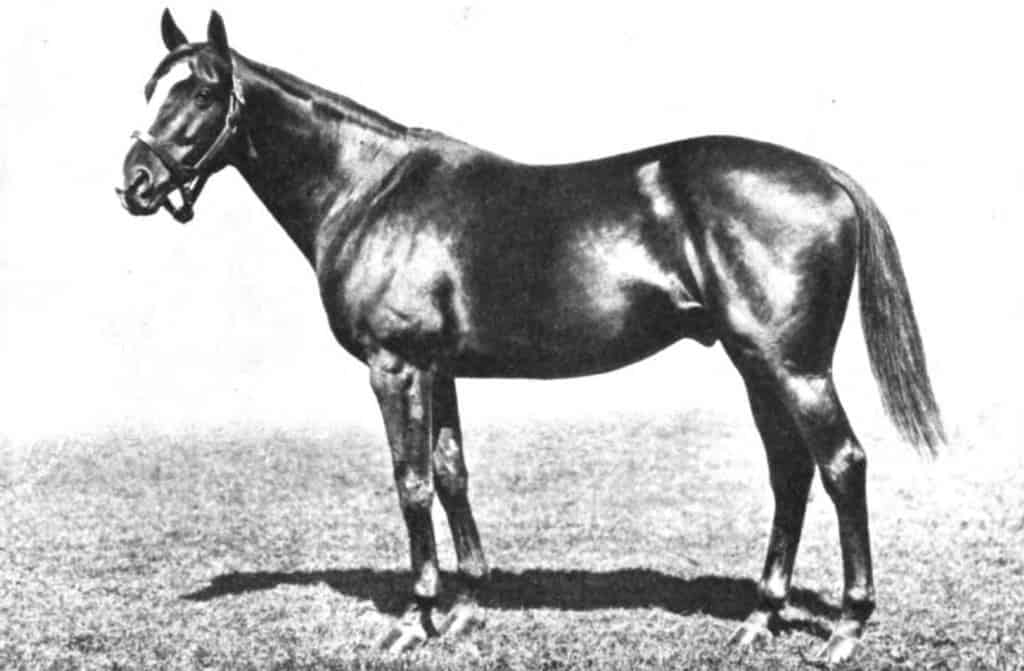
Sir Barton was the first winner of the American Triple Crown.
©W. A. Rouch, Public domain, via Wikimedia Commons – License
Sir Barton was the first horse to win the Triple Crown in 1919. Sir Barton was a grouchy chestnut colt born in Kentucky who hated everyone. However, he did have a soft spot for his groom, Toots Thompson. As a two-year-old, Sir Barton competed but did not show much promise. In addition, a cut from a stablemate gave the horse blood poisoning, so he was unable to finish the season.
After recovering from his illness, Sir Barton made his maiden debut in the Kentucky Derby (a maiden horse is one that has not yet won a race). During the race, Sir Barton showed his true colors and led the entire thing from start to finish, winning by five lengths! Traveling to Baltimore, Sir Barton led the race again in the Preakness Stakes, winning by four lengths. In New York, he next won the Withers Stakes and, shortly thereafter, won the Belmont Stakes on June 11. Sir Barton’s accomplished this miraculous four-streak win in just 32 days! He was retroactively declared Horse of the Year for 1919.
2. Gallant Fox (1930)
Born in Paris, Kentucky, Gallant Fox was a large horse with a distinctive white blaze. Gallant Fox was obviously a skilled racing horse but also easily distracted. In fact, during his maiden race, a low-flying airplane caught the horse’s eye and delayed his break from the starting gate. Gallant Fox also refused to run alone. So, his trainer “Sunny Jim” Fitzsimmons placed other horses around the track during training.
In 1930 Gallant Fox was the odds-on favorite in the Preakness States, and, true to form, he shot from the gate like a rocket and seized an early lead down the homestretch. However, he broke rather sluggishly in the Kentucky Derby from the gate. However, he made up ground along the backstretch and surged to the front of the pack. Despite sloppy conditions and driving rain, the horse won by two lengths in a swift 2:07 ⅗. He then went on to win the Belmont Stakes, securing the Triple Crown. Gallant Fox was also retrospectively honored as the American Horse of the Year for 1930.
An impressive horse champion, Gallant Fox is also the only horse to win the Triple Crown and sire a Triple Crown winner — his son, Omaha.
3. Omaha (1935)
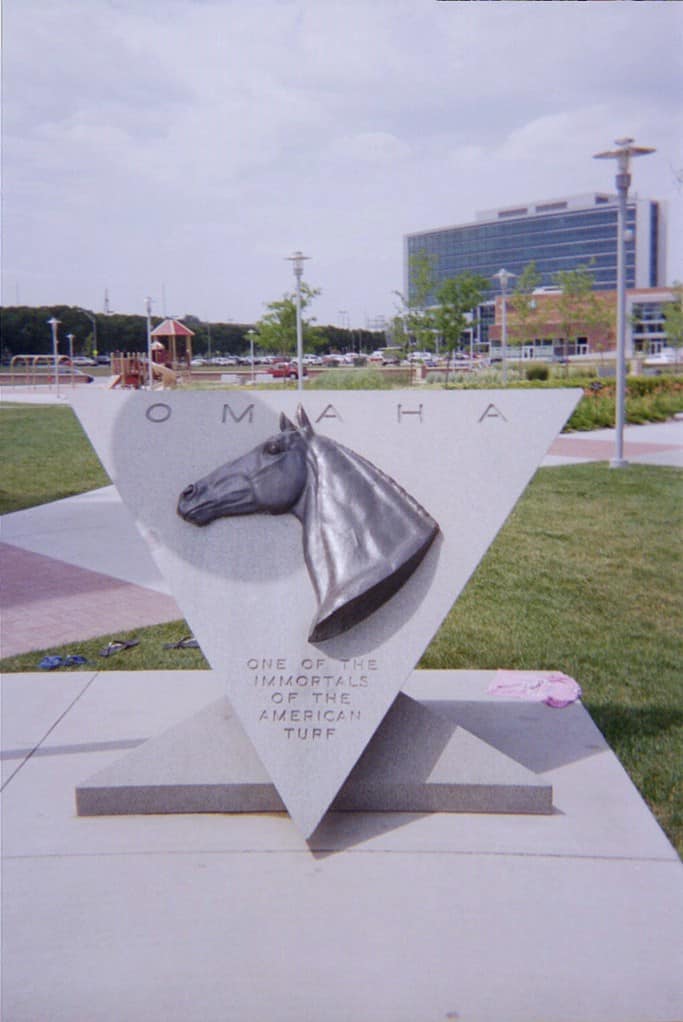
Omaha raced throughout the United States and England, but owners retired him after he became lame before the 1937 Ascot Gold Cup.
©DandyDan2007/ CC BY 3.0 – License
Sired by Triple Crown winner Gallant Fox and the mare Flambino, Omaha was born in 1932 in Paris, Kentucky. The beautiful chestnut horse also had a white blaze like his father, although he was a bit awkward and leggy as a yearling. However, Ohama grew to be a large and imposing horse who stood 16.3 hands high (about 65.2 inches at the top of the horse’s shoulder). Sunny Jim Fitzsimmons trained both Omaha and his father Gallant Fox.
A heavy downpour and freezing weather occurred when Omaha competed in the 1935 Kentucky Derby. However, Omaha’s steely determination and unmatched endurance took him through the backstretch and up to the lead position, leaving other competitors in the muddy dust. In fact, his jockey Smokey Saunders never even had to use his whip!
Omaha easily took the win at the Preakness Stakes by six lengths. Then at the Belmont Stakes, Omaha once again shot through a muddy track. He moved from the back of the pack into the lead and won the race — and the Triple Crown — as he crossed the finish line, covered in mud.
4. War Admiral (1937)

War Admiral raced against Seabiscuit in the race known as “The Match of the Century” in 1938.
©Boston Public Library / Public Domain via Wikimedia Commons – License
The fourth horse to win the Triple Crown was War Admiral, the son of one of the greatest racing horses of all time, Man o’ War. Man o’ War was 16.3 hands high (about 65.2 inches), but his son War Admiral only reached 15.2 or 15.3 hands high (60.8 to 61.2 inches). However, when it came to racing, War Admiral was definitely his father’s son and inherited his father’s feisty disposition. War Admiral frequently put up quite the fight at the starting gate and refused to be contained.
In fact, although he won the Kentucky Derby in 1937, War Admiral delayed the start for several minutes. At the Preakness stakes, the feisty colt again acted up at the start. He also struggled with some of the turns, but ultimately he won the race. Then at the Belmont Stakes, War Admiral again caused trouble at the start, causing an eight-minute delay. When the race finally began, War Admiral stumbled as he left the gate but quickly regained his composure and charged ahead, winning the race by three lengths. However, after the race onlookers discovered that when War Admiral had stumbled at the gate, he struck the quarter of his right front for foot. The horse, now covered in blood on his legs and belly, had a gaping wound.
Unfortunately, the injury was severe enough that War Admiral could not compete during the summer season. However, he made his triumphant return to the track in October and won three more races, demonstrating his unbeatable spirit and champion bloodline. He was Horse of the Year in 1937, beating out the famous Seabiscuit for the title. He was also the Champion Three-Year-Old as well.
5. Whirlaway (1941)

Whirlaway was Horse of the Year, a Triple Crown Winner, and also won the “Superfecta.”
©Boston Public Library / From painting by Ann Collins “Tichnor Quality Views”, Reg,U.S.Pat.Off., Made Only by Tichnor Bros., Inc., Boston, Mass., Public domain, via Wikimedia Commons
Born in 1938, Whirlaway became the fifth horse to win the Triple Crown in 1941. Whirlaway was a beautiful horse with a long, lush tail. However, he had a habit of bearing out and drifting toward the middle of the track. Before racing in the Kentucky Derby, his trainer Ben A. Jones put a special full-cup blinker over the horse’s right eye. This helped to narrow his vision and keep him on a straight path. Jones then cut a small hole in the blinker so that Whirlaway could see him during the race. It was an unusual tactic, but it worked — Whirlaway won the Kentucky Derby with a record margin of eight lengths!
In addition to his wins at the Kentucky Derby, the Preakness Stakes, and the Belmont Stakes, Whirlaway also captured the coveted “Superfecta” or “Grand Slam of Thoroughbred Racing”. Although it is not an official award, this informal title refers to horses that win both the Triple Crown as well as the Travers Stakes or the Breeders’ Cup Classic in the same year. Whirlaway is still the only horse to win both the Triple Crown and the Grand Slam with the Travers Stakes as of 2022 (the only other horse to achieve a Grand Slam was American Pharoah, but he did so with the Breeders’ Cup Classic). Whirlaway was Horse of the Year for 1941 and again for 1942.
6. Count Fleet (1943)

Count Fleet sired Kentucky Derby winner Count Turf and Belmont Stakes winners Counterpoint and One Count.
©Srca1941 / CC BY SA-3.0 – License
Before becoming a champion racehorse, Count Fleet was well known for his awkward appearance and his rebellious and often erratic temperament. However, by the time he was two years old, Count Fleet became one of the greatest American racehorses of the 20th century and completed his three-year-old season without losing a single race!
In fact, despite several injuries before the Kentucky Derby in 1943, Count Fleet won the prestigious race by three lengths. He continued to impress on the track in Baltimore, dominating the Preakness Stakes with a remarkable eight-length lead. Then in New York, Count Fleet delivered an incredible 25-length victory in the Belmont stakes, securing the Triple Crown and setting a record that would only be surpassed by Secretariat 20 years later. His incredible performance throughout the 1943 racing season earned Count Fleet the title of Champion Three-Year-Old and the American Horse of the Year. The amazing horse lived to be 33 years old, making him the longest-lived Kentucky Derby winner ever.
7. Assault (1946)

Eddie Acaro rode Assault and detailed his exploits in his 1951 memoir “I Ride to Win.”
©Eddie Arcaro, “I ride to win!”, New York, Greenberg and Co. (1951)/ Public Domain via Wikimedia Commons – License
So far, Assault is the only Texas-bred horse to win the Triple Crown. Despite facing numerous injuries and illnesses early on in his life, Assault grew into a true champion on the racetrack. When he was a young colt, Assault stepped on a surveyor’s stake, leaving him with a permanent limp and a deformed right hoof. In addition, as he got older, Assault battled bravely through knee, kidney, fetlock, splint bone, and bleeding problems, proving to be one of the strongest and most resilient racehorses in history.
Despite being counted out as an outsider, Assault stunned everyone in the Kentucky Derby of 1946. He rode past his competitors and won by eight lengths — a record tie with that of Whirlaway back in 1941! But Assault wasn’t done just yet. In his third Triple Crown race, Assault stumbled at the start, leaving him trailing the other competitors. However, with just 200 yards left to go, Assault surged ahead once again and won the Belmont Stakes by three lengths. Assault was honored as the Champion Three-Year-Old and the Horse of the Year.
8. Citation (1948)
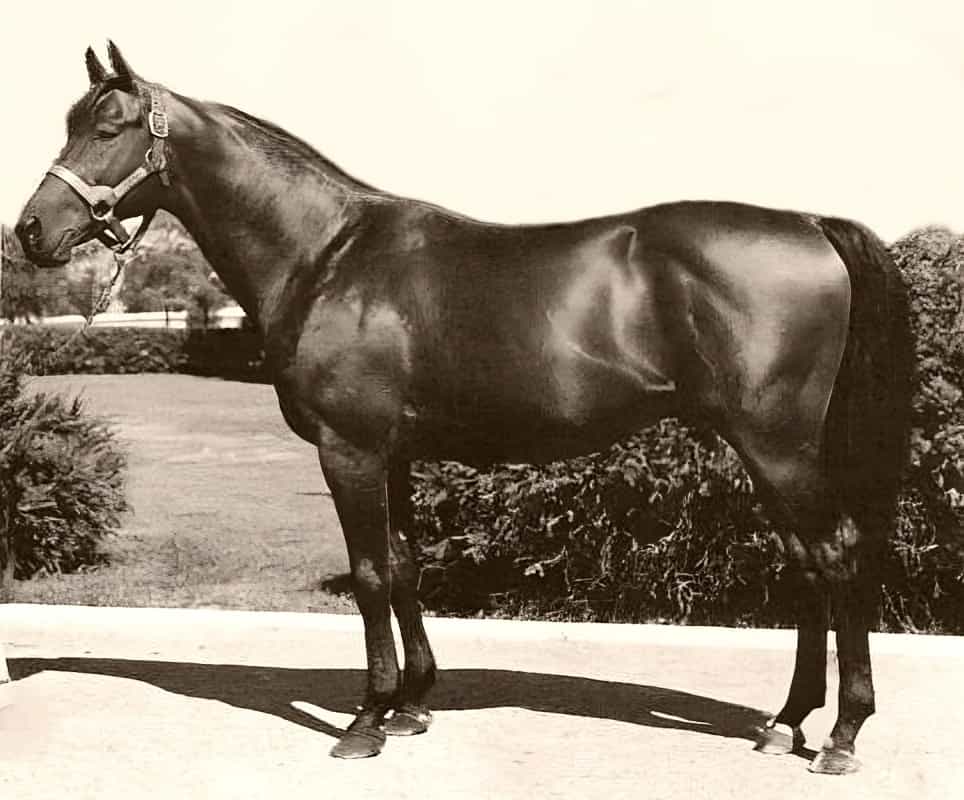
Citation was the first horse in U.S. racing history to win $1 million dollars.
©Goreen Collection / Public Domain via Wikimedia Commons – License
Owned and bred in Kentucky, Citation was a big colt with a surprisingly diverse pedigree that traced back to horses from New Zealand and England. As the Champion Two-Year-Old, Citation only lost one race and won eight starts. Citation began his three-year-old season by winning two races over the older Armed, a top racing horse who had been the Horse of the Year in 1947.
Citation won the Kentucky Derby by three and a half lengths, the Preakness Stakes by 5 1/2, and the Belmont Stakes, capturing the Triple Crown. However, the incredible horse didn’t stop there. Citation continued the 1948 season with 20 starts, 19 wins, and a 15-race winning streak. The horse was overwhelmingly voted as the Horse of the Year for 1948, receiving all but two votes.
However, by the end of the 1948 season, Citation developed an osselet (arthritis in one of his fetlock joints). Unfortunately, this kept him from racing the following year, but he did return in 1950. His many wins and successes led him to become the first horse to win over $1 million dollars in career earnings.
9. Secretariat (1973)
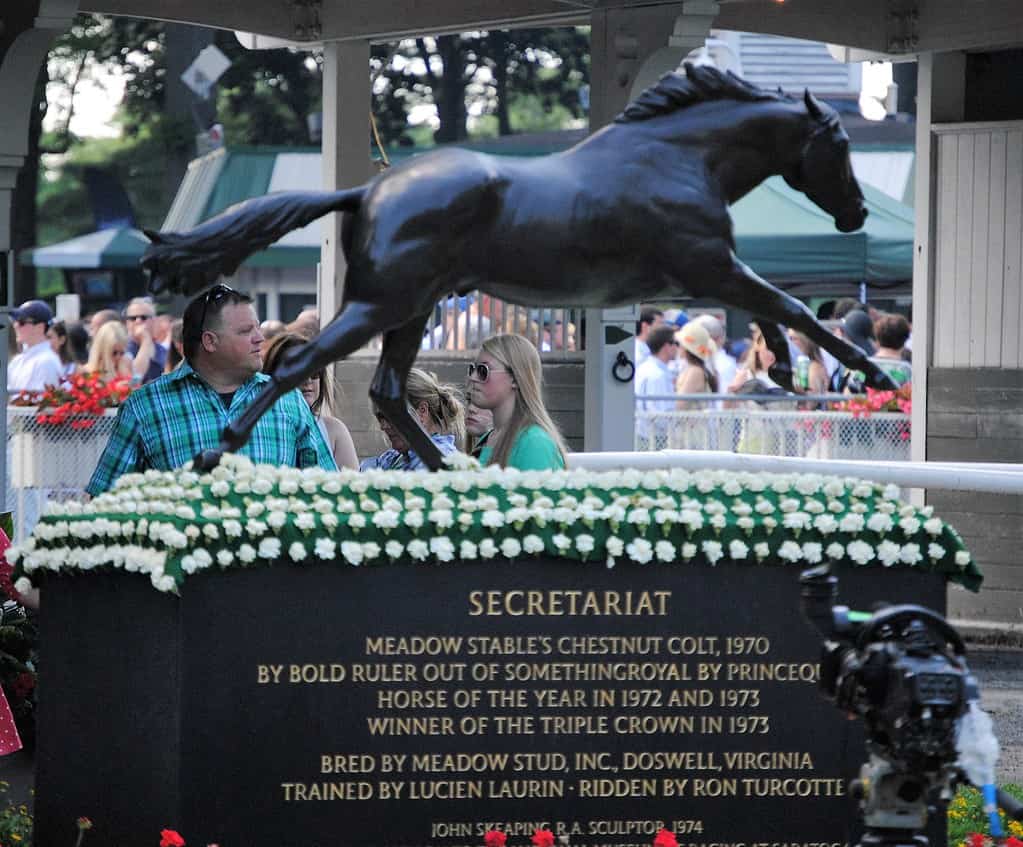
Secretariat is one of the most famous racehorses in the world.
©Jlvsclrk/ CC BY-SA 3.0 – License
At home, the red chestnut colt was fondly known as “Big Red”, but the rest of the world knew him as Secretariat, one of the most famous horses in history. Thanks to the 1975 book Secretariat: The Making of a Champion by William Nack and the 2010 Disney film Secretariat, this incredible racehorse is a household name. Secretariat shattered the speed records for all three prestigious Triple Crown races and continues to hold the record today. Secretariat’s unparalleled performance early on in his career earned him the coveted Eclipse Award for Champion Two-Year-Old Colt. He was Horse of the Year in 1972, an honor almost never given to a horse so young.
In an incredible feat that still leaves people in awe to this very day, Secretariat won the Belmont Stakes by 31 lengths, securing the Triple Crown in 1973. The incredible horse also shattered speed records in each of the Triple Crowns’ three races. In fact, Secretariat’s speed was so unbelievable that it was not until 2012 that his Preakness Stakes record was officially accepted.
Secretariat’s success made him a national sensation to the public, capturing the hearts of audiences all across the country. He was even featured on the covers of some of the biggest magazines around, like Sports Illustrated, Newsweek, and Time. In 1973 he was the American Champion Three-Year-Old Male Horse, the American Champion Male Turf Horse, and the Horse of the Year.
10. Seattle Slew (1977)
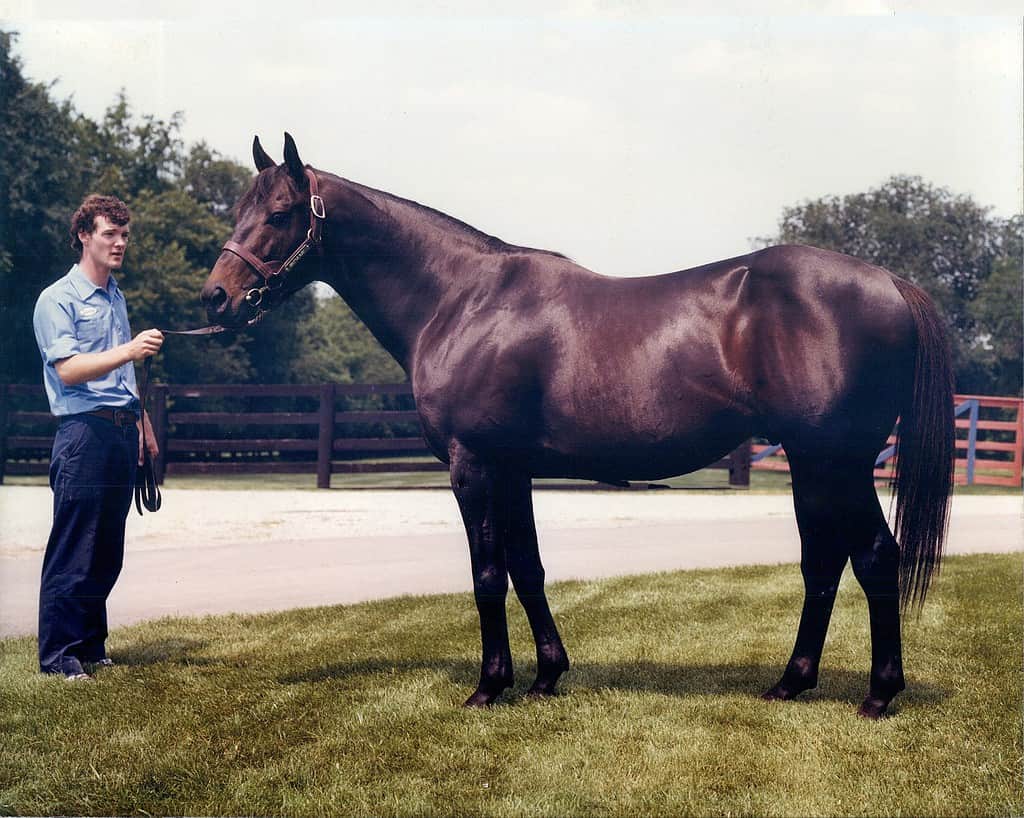
Seattle Slew’s name originates from the states of Washington and Florida, which his owners were from. Slew is another word for swamp.
©Pawneese / CC BY-SA 4.0 – License
Seattle Slew was an impressive dark bay horse who stood 16.5 hands high (66 inches) with a powerful shoulder and strong hind legs. He only started three times when he was two years old, but his incredible skill led him to become the Champion Two-Year-Old in 1976. Seattle Slew took running seriously and rode hard and fast every time. Even in easy races and simple workouts, Seattle Slew’s trainer struggled to get the horse to calm down and feared that he would hurt himself because he was using up too much energy.
Fortunately, by the time he competed in the Kentucky Derby in 1977, Seattle Slew had learned to relax a little before his race. He won all three races in the Triple Crown, finishing off the Belmont Stakes easily by four lengths.
25 years after he won the coveted triple crown, Seattle Slew’s whole body was laid to rest at Hill ‘n’ Dale — a high honor for a racing horse. The farm also ensured that this remarkable horse was buried alongside his favorite blanket and a pack of peppermints.
11. Affirmed (1978)

Champion racehorse Affirmed was inducted into the U.S. Racing Hall of Fame in 1980.
©Visindar / CC BY-SA 3.0 – License
Bred in Florida, Affirmed was a lovely chestnut horse. When he was two years old, Affirmed won several different races and was named the Champion Two-Year-Old Horse. When he was three years old, Affirmed won the Triple Crown. He would be the last horse to win this coveted honor for 37 years, setting a record for the longest gap between winners.
Affirmed was the American Champion Three-Year-Old and the Horse of the Year for 1978. In 1979 he again earned the title of Horse of the Year and the American Champion Older Male Horse. Throughout his career, Affirmed had 22 wins from 29 starts. He came in second in five races and in third place once. His trainer compared Affirmed to the legendary Secretariat, claiming that Affirmed was the better racehorse, as he had to face the impressive Alydar as his archrival throughout his successful career.
12. American Pharoah (2015)
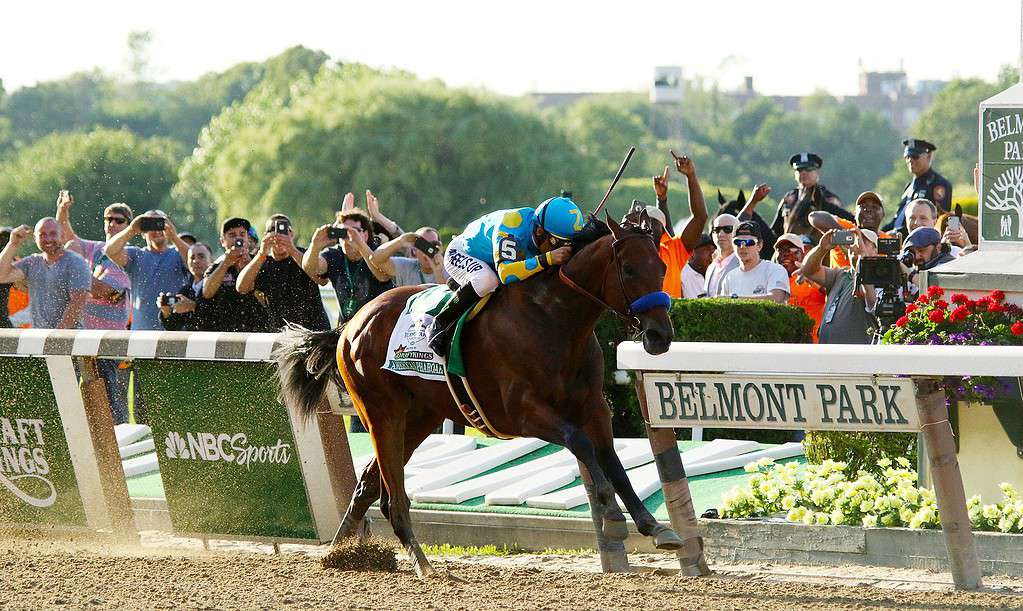
American Pharoah is the first horse to win the grand slam of thoroughbred racing when he won both the Triple Crown and Breeders Cup Classic.
©Froggerlaura and Mike Lizzi/ CC BY-SA 2.0 – License
Born in February 2012, American Pharoah is unique for a racing horse, as he is not at all aggressive. In fact, American Pharoah seems to be quite fond of people and has a sweet, gentle demeanor. His name honors both his sire, Pioneer of the Nile, as well as the Egyptian-American background of his breeder and owner, Ahmed Zayat. The accidental misspelling of the horse’s name (“pharoah” instead of “pharaoh”) went unnoticed during registration — but since it met all the requirements, it became the horse’s permanent name.
By the end of his second year, American Pharoah became the American Champion Two-Year-Old Male Horse. Then on June 6, 2015, American Pharoah ended the 37-year Triple Crown drought by winning the Belmont Stakes. In addition, American Pharoah also won the Breeders’ Cup Classic, becoming the second horse to ever obtain the Grand Slam of Thoroughbred Racing — and the very first to ever do it with the Breeders’ Cup Classic.
At the end of the season, American Pharoah was unanimously chosen as the American Horse of the Year and the champion Three-Year-Old Male Horse. He retired after the 2015 season. As of 2023, American Pharoah is one of just two living Triple Crown-winning horses.
13. Justify (2018)
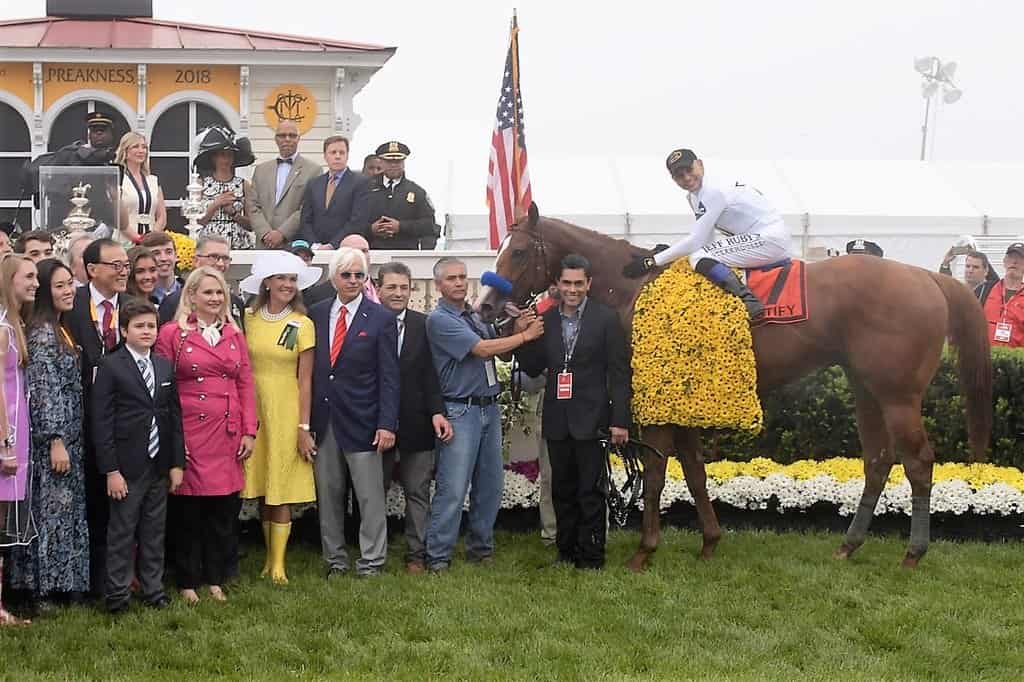
Justify is the most recent horse to win the Triple Crown and did so in 2018.
©Maryland GovPics / CC BY 2.0 – License
The most recent Triple Crown win came from Justify, a massive chestnut horse with 16.3 hands (16.2 inches) and weighing between 1,200 and 1,300 pounds during his Triple Crown races in 2018. However, Justify didn’t begin competing until he was already three years old, which is very unusual. Winning the Kentucky Derby without any second-year experience is almost completely unheard of. In fact, the last horse without second-year experience to win the Kentucky Derby was Apollo — back in 1882!
Justify received training from American Pharoah’s trainer, Bob Baffert. When he competed in the Kentucky Derby, Justify went up against several horses that were much more experienced winners. The track was also muddy and sloppy, but Justify somehow won the race without getting hardly any mud on him! Two weeks later, when he competed in the Preakness Stakes, track conditions were even worse from rainstorms and heavy fog. However, Justify prevailed and became the thirteenth horse to win the American Triple Crown. The win also made Justify the second horse to win the Triple Crown while still being undefeated!
The Only Horses to Ever Win the Triple Crown
| Order | Triple Crowned Horse | Year |
|---|---|---|
| 1 | Sir Barton | 1919 |
| 2 | Gallant Fox | 1930 |
| 3 | Omaha | 1935 |
| 4 | War Admiral | 1937 |
| 5 | Whirlaway | 1941 |
| 6 | Count Fleet | 1943 |
| 7 | Assault | 1946 |
| 8 | Citation | 1948 |
| 9 | Secretariat | 1973 |
| 10 | Seattle Slew | 1977 |
| 11 | Affirmed | 1978 |
| 12 | American Pharoah | 2015 |
| 13 | Justify | 2018 |
The photo featured at the top of this post is © Froggerlaura and Mike Lizzi/ CC BY-SA 2.0 – License / Original
Thank you for reading! Have some feedback for us? Contact the AZ Animals editorial team.






